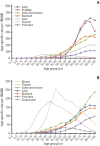Cancer Statistics in Korea: Incidence, Mortality, Survival, and Prevalence in 2022
- PMID: 40083085
- PMCID: PMC12016816
- DOI: 10.4143/crt.2025.264
Cancer Statistics in Korea: Incidence, Mortality, Survival, and Prevalence in 2022
Abstract
Purpose: The current study provides national cancer statistics and their secular trends in Korea, including incidence, mortality, survival, and prevalence in 2022, with international comparisons.
Materials and methods: Cancer incidence, survival, and prevalence rates were calculated using the Korea National Cancer Incidence Database (1999-2022), with survival follow-up until December 31, 2023. Mortality data obtained from Statistics Korea, while international comparisons were based on GLOBOCAN data.
Results: In 2022, 282,047 newly diagnosed cancer cases (age-standardized rate [ASR], 287.0 per 100,000) and 83,378 deaths from cancer (ASR, 65.7 per 100,000) were reported. The proportion of localized-stage cancers increased from 45.6% in 2005 to 50.9% in 2022. Stomach, colorectal, and breast cancer showed increased localized-stage diagnoses by 18.1, 18.5, and 9.9 percentage points, respectively. Compared to 2001-2005, the 5-year relative survival (2018-2022) increased by 20.4 percentage points for stomach cancer, 7.6 for colorectal cancer, and 5.6 for breast cancer. Korea had the lowest cancer mortality among countries with similar incidence rates and the lowest mortality-to-incidence (M/I) ratios for these cancers. The 5-year relative survival (2018-2022) was 72.9%, contributing to over 2.59 million prevalent cases in 2022.
Conclusion: Since the launch of the National Cancer Screening Program in 2002, early detection has improved, increasing the diagnosis of localized-stage cancers and survival rates. Korea recorded the lowest M/I ratio among major comparison countries, demonstrating the effectiveness of its National Cancer Control Program.
Keywords: Incidence; Korea; Mortality; Neoplasms; Prevalence; Survival.
Conflict of interest statement
Conflict of interest relevant to this article was not reported.
Figures










References
-
- Ferlay J, Ervik M, Lam F, Laversanne M, Colombet M, Mery L, et al. Global Cancer Observatory: Cancer Today (version 1.1) [Internet] International Agency for Research on Cancer; 2024 [cited 2024 Dec 14]. Available from: https://gco.iarc.who.int/today/
-
- Statistics Korea [Internet]. Statistics Korea; 2025 [cited 2024 Dec 14]. Available from: https://kosis.kr.
-
- Ajiki W, Tsukuma H, Oshima A. Index for evaluating completeness of registration in population-based cancer registries and estimation of registration rate at the Osaka Cancer Registry between 1966 and 1992 using this index. Nihon Koshu Eisei Zasshi. 1998;45:1011–7. - PubMed
-
- World Health Organization International classification of Diseases for Oncology (ICD-O), 3rd ed. 2nd rev. [Internet] World Health Organization; 2019 [cited 2025 Feb 14]. Available from: https://iris.who.int/handle/10665/96612.
MeSH terms
Grants and funding
LinkOut - more resources
Full Text Sources
Medical

